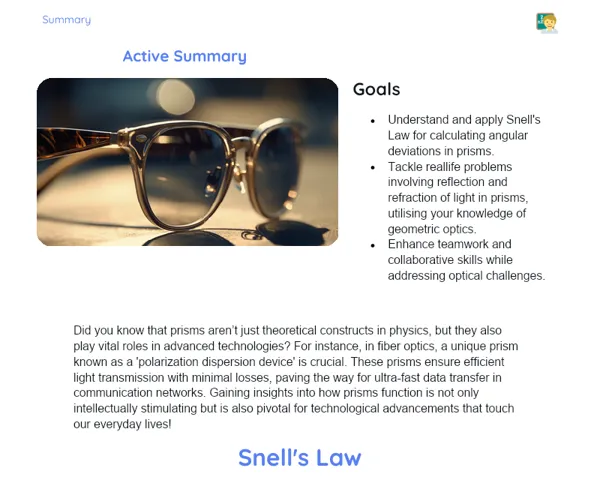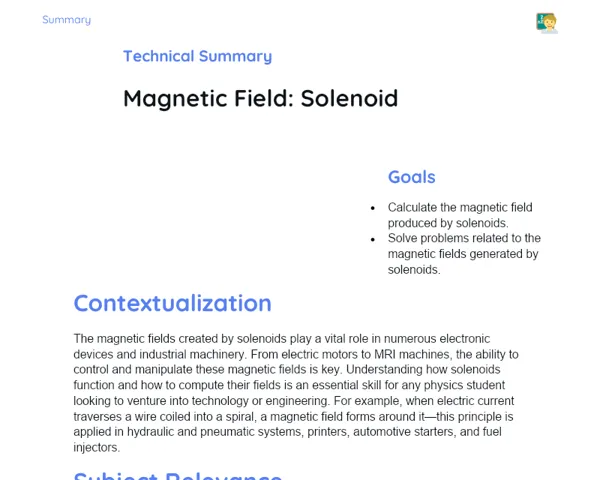Socioemotional Summary Conclusion
Goals
1. 🌟 Grasp the connection between electric charges, the distance separating them, and the force generated according to Coulomb's Law.
2. 🧮 Utilize Coulomb's Law to tackle practical problems that involve forces between two point charges at various distances.
Contextualization
🔍 Did you know that the static electricity that makes your hair stand on end when you remove a sweater happens due to electric charge interactions? These tiny shocks we experience daily are directly tied to Coulomb's Law! Imagine the power of grasping and managing these unseen forces! Let's delve into how charges interact and uncover the mysteries behind electricity! ⚡✨
Exercising Your Knowledge
Coulomb's Law
Coulomb's Law defines the force acting between two point electric charges. This force is directly proportional to the product of the charges and inversely proportional to the square of the distance between them. Thus, the closer the charges, the stronger the force, and vice versa.
-
📏 Inverse Proportionality: The force diminishes as the distance between the charges increases. When the distance doubles, the force reduces to a quarter of its initial value.
-
🔋 Direct Proportionality: If the magnitude of one charge increases, the force will also rise. Doubling one charge leads to a doubling of the force.
-
🌍 Comparison with Gravity: Similar to gravitational force, electric force adheres to an inverse square law, but unlike gravity, it can be either repulsive or attractive.
Coulomb's Law Formula
The formula for Coulomb's Law serves as a basic tool for calculating the force between two charges. It's expressed as F = k * (|q1 * q2| / r^2), where F indicates the force, k is the electrostatic constant, q1 and q2 are the charges, and r represents the distance separating them. Mastering this formula is crucial for solving practical physics challenges.
-
🔢 Electrostatic Constant (k): The constant k is approximately 8.99 × 10^9 N·m²/C². This impressive value illustrates just how strong electric forces can be.
-
📊 Magnitudes of the Charges (q1 and q2): Charges can be positive or negative, and their sign determines if the force will be attractive or repulsive.
-
📉 Distance (r): The r^2 in the formula’s denominator highlights that the force drops significantly as the distance between the charges increases.
Coulomb Simulations
Interactive simulations offer a fantastic way to visualize the workings of Coulomb's Law in action. By manipulating the charge magnitudes and distances, students can observe the changes in force directly, reinforcing their theoretical understanding through a lively and engaging method.
-
💻 Interactive Exploration: Enables students to modify parameters and observe how these changes impact electric force, fostering a more instinctive grasp.
-
👥 Teamwork: Pairing up for simulations encourages collaboration and communication, which are essential skills for both academic and personal growth.
-
📈 Data Recording: Recording observations and engaging in discussions enables students to practice critical and analytical skills.
Key Terms
-
Coulomb's Law: The principle that explicates the force of interaction between two point electric charges.
-
Electrostatic Constant (k): A value that quantifies the force of electric interaction, roughly 8.99 × 10^9 N·m²/C².
-
Electric Force: The force originating from the interaction between two charges, which may be attractive or repulsive.
-
Electric Charges: The characteristics of particles that experience force within an electric field.
For Reflection
-
🤔 How do you feel when tackling complex concepts like Coulomb's Law? What emotional responses do you encounter, and how do you navigate through them?
-
🌐 Are there other areas in your life where you observe interactions akin to 'charges' (people, emotions, ideas) that follow similar patterns to Coulomb's Law?
-
💬 How did collaboration and communication during simulations and group discussions influence your understanding of the topic? What strategies helped you handle emotional challenges during these activities?
Important Conclusions
-
🔍 Coulomb's Law aids us in comprehending the force between electric charges and how it varies with the distance between them.
-
🧮 The formula F = k * (|q1 * q2| / r^2) is vital for resolving practical physics problems related to point charges.
-
🌍 Electric force, similar to gravitational force, conforms to an inverse square law concerning distance, yet can be attractive or repulsive.
-
💻 Coulomb simulations serve as an impactful tool for visualizing theoretical concepts in practice and reinforcing learning.
-
🤝 Effective collaboration and clear communication with peers can significantly enhance your understanding and capability in addressing intricate problems.
Impacts on Society
🌐 Concepts of electricity and Coulomb's Law influence our daily lives, from the operation of gadgets to occurrences such as static electricity. With a better grasp of Coulomb's Law, students can gain insights into these everyday experiences and appreciate the underlying physics that governs our surroundings.
💬 On a personal level, recognizing how charges interact can facilitate our reflection on human and emotional dynamics. Just as opposite charges attract, individuals with contrasting emotions and energies could complement one another. Conversely, excessive similarities might lead to repulsion. By understanding these dynamics, we can foster empathy and enhance our communication and relationship skills, leading to healthier social interactions.
Dealing with Emotions
To manage your emotions while studying Coulomb's Law and its applications, I suggest an exercise based on the RULER method. Begin by allocating some quiet time at home to contemplate your feelings during the lessons and activities. Identify and articulate these emotions, whether they are excitement, frustration, or curiosity. Try to uncover the roots of these emotions and their influence on your learning. Next, jot down ways to express these emotions positively and regulate your feelings, like employing breathing techniques or taking deliberate breaks. This practice will enhance your self-regulation and improve your learning experience.
Study Tips
-
📝 Summarize the key aspects of Coulomb's Law and develop practical examples to aid memorization.
-
💻 Leverage online interactive simulations to visualize how variations in charges and distances impact the electric force. Experimenting with diverse scenarios will bolster your understanding.
-
👥 Engage in group studies; discuss your queries and findings with friends. The exchange of thoughts can clarify concepts and provide fresh perspectives.



